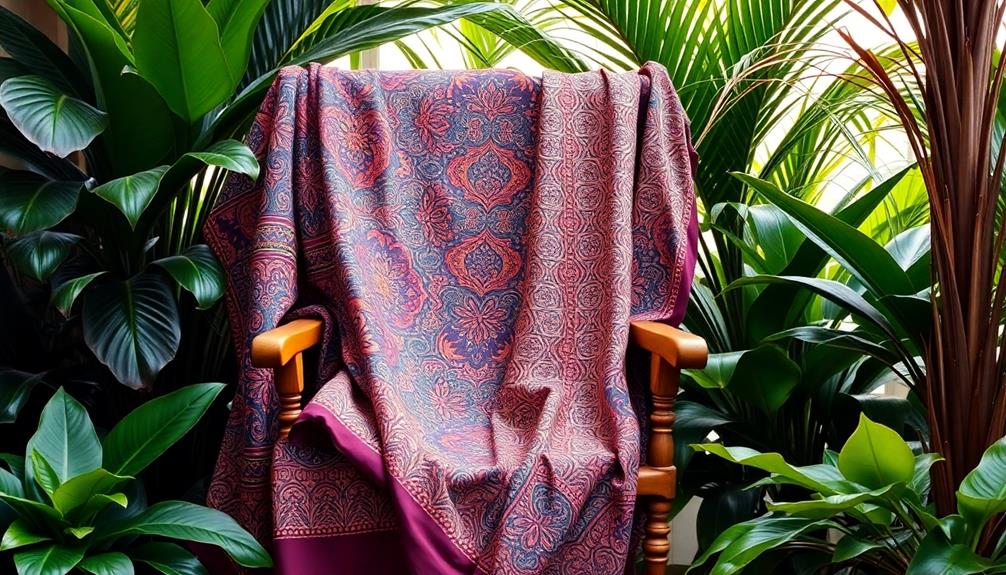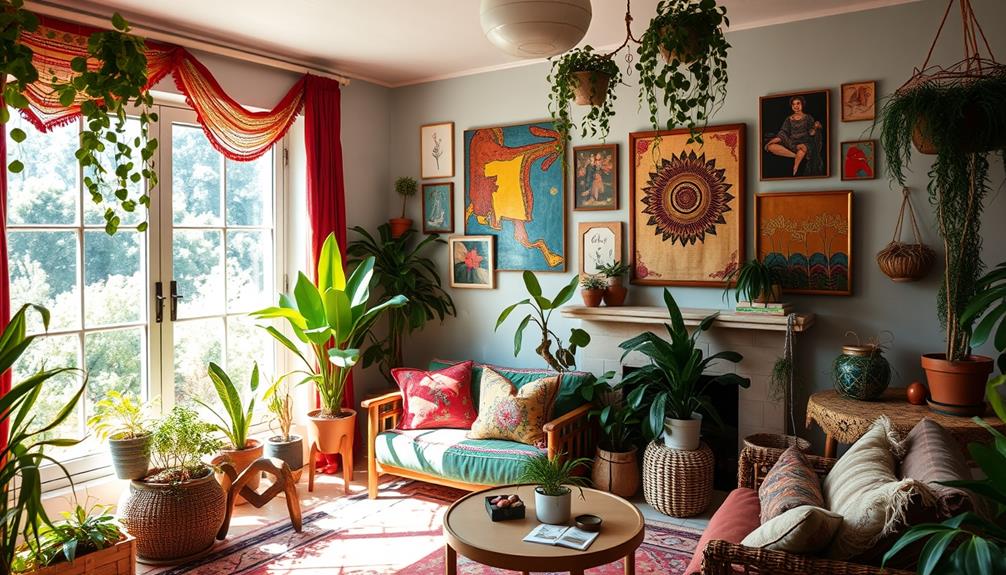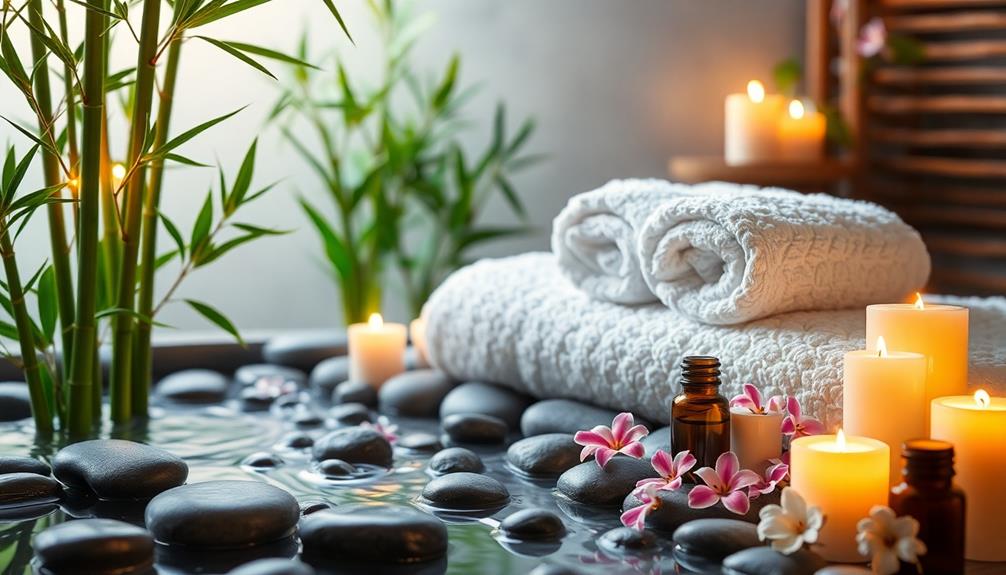Indonesian textiles are the one design element that'll truly wow your guests. Their vibrant patterns and rich cultural heritage speak volumes about artistry and tradition. Whether it's a stunning batik wall hanging or luxurious songket table runner, these pieces add depth and a story to your decor. You'll find that each fabric connects to the diverse cultures of Indonesia, sparking interest and conversation. Plus, integrating these textiles into your space creates a unique, inviting atmosphere. Explore how to elevate your decor with these stunning textiles and see what extraordinary pieces can bring to your home.
Key Takeaways
- Indonesian textiles, like batik and ikat, bring vibrant colors and intricate patterns that instantly captivate and enhance any space's aesthetic.
- Unique designs reflect rich cultural stories, making them conversation starters that impress guests with their historical significance and artistry.
- Incorporating statement pieces, such as batik wall hangings or songket table runners, adds luxurious texture and depth to your decor.
- Layering different textiles creates visual interest, transforming a space into an inviting environment that showcases craftsmanship and cultural heritage.
- Sustainable and ethical craftsmanship in contemporary interpretations of traditional textiles appeals to eco-conscious guests, highlighting your commitment to responsible design.
The Allure of Indonesian Textiles
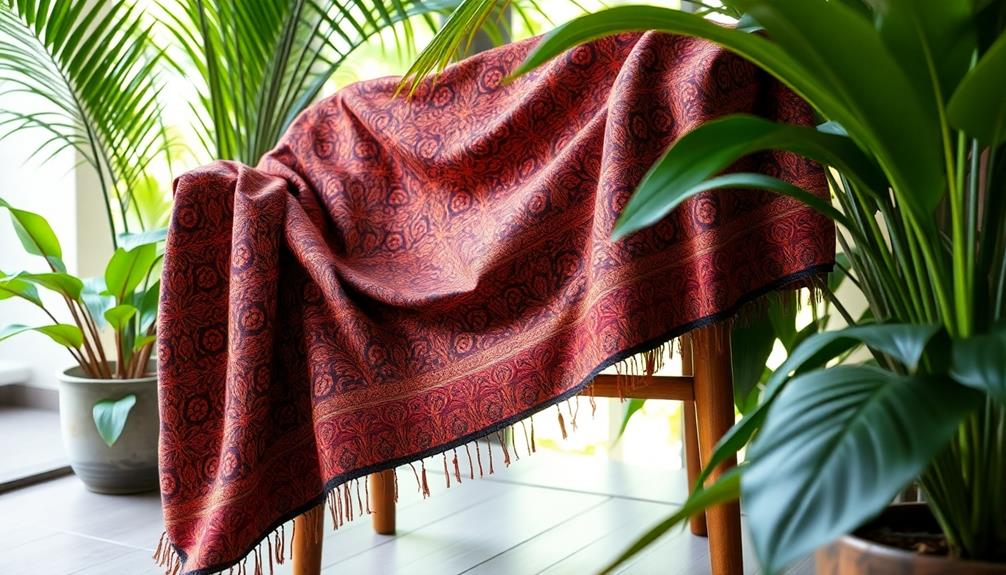
When you explore the world of Indonesian textiles, you'll discover a fascinating blend of artistry and tradition that speaks to the heart of the nation's diverse cultures. Renowned for their intricate patterns and vibrant colors, Indonesian textiles like batik, ikat, and songket reflect the rich heritage of over 300 ethnic groups across Indonesia's 13,667 islands.
These textiles not only enhance aesthetics but also encourage appreciation for traditional craftsmanship, much like the unique artistic expressions found in Indonesian decor masks.
Batik, recognized by UNESCO as a Masterpiece of Oral and Intangible Heritage, enchants with its symbolic motifs inspired by nature and mythology. The traditional wax-resist dyeing technique gives it a unique texture and depth.
In contrast, ikat textiles showcase blurred patterns from a tie-dye technique applied to the threads before weaving, representing local traditions and cultural identities, especially in regions like Nusa Tenggara and Sumatra.
Songket stands out as a luxurious fabric, woven with gold or silver threads. Traditionally worn during ceremonial occasions, it symbolizes wealth and social status, particularly in Sumatra and Bali.
The allure of Indonesian textiles lies not only in their stunning designs but also in the stories and craftsmanship they encapsulate, making them an enchanting design element that will truly wow your guests.
Key Textile Techniques
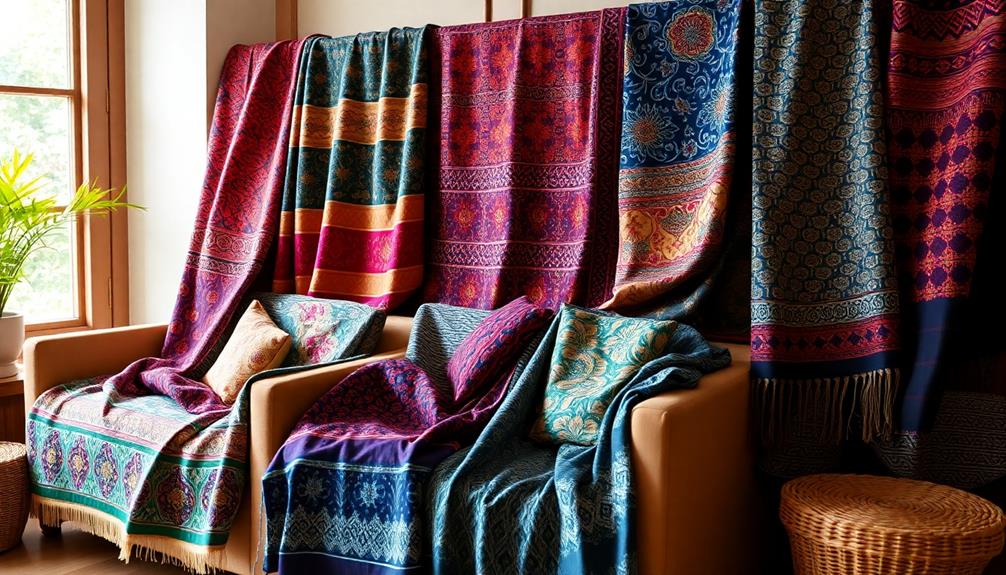
Indonesian textiles aren't just visually stunning; they also embody a variety of intricate techniques that reflect the country's rich cultural tapestry. Each method tells a story, showcasing artistry and tradition that can truly wow your guests.
Additionally, many of these textiles often feature designs similar to traditional Indonesian decor masks, which enhance aesthetic appeal and celebrate cultural heritage vibrant artistry reflects rich Indonesian culture.
- Batik Textiles: This wax-resist dyeing technique from Java involves layering wax and dye to create intricate patterns inspired by nature and mythology. It's recognized by UNESCO and is a staple in Indonesian culture.
- Ikat: A tie-dye technique where threads are dyed before weaving, resulting in beautiful, blurred patterns perfect for sarongs and shawls.
- Songket: This luxurious fabric, woven with gold or silver threads, symbolizes wealth and is often reserved for ceremonial occasions.
These techniques, along with appliqué and embroidery, showcase the diverse craftsmanship found in Indonesian textiles.
Appliqué involves sewing accessory fabrics onto a base textile, while embroidery adds decorative stitching post-weaving, enhancing both aesthetic and symbolic value.
Cultural Significance and History
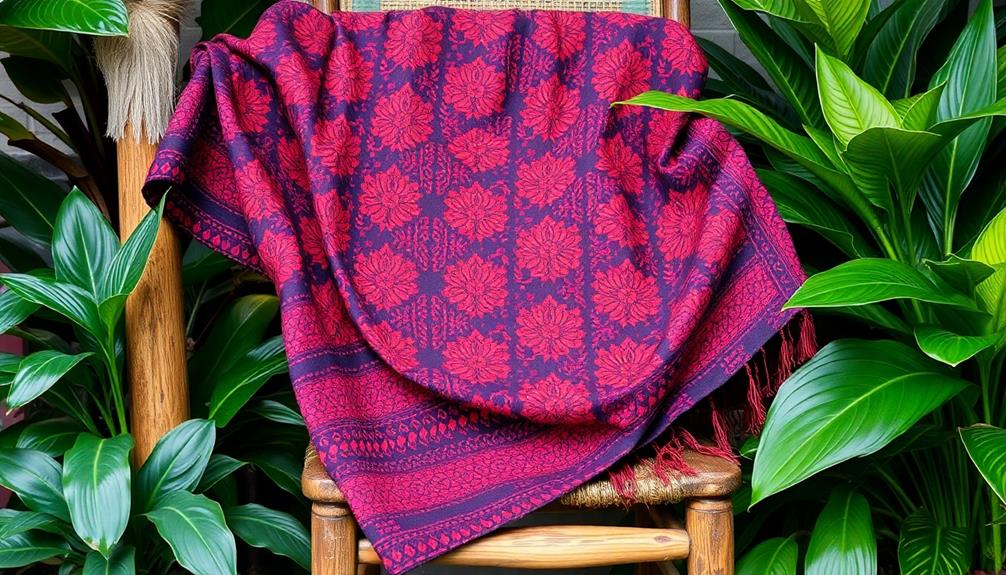
Rooted in a rich tapestry of cultural heritage, Indonesian textiles are more than just decorative items; they embody the history, beliefs, and practices of over 300 ethnic groups across the archipelago. Each piece tells a story, reflecting the unique identities of its creators.
For instance, batik, recognized by UNESCO as a Masterpiece of Oral and Intangible Heritage, employs a wax-resist dyeing technique that produces intricate patterns celebrating nature and mythology, particularly in Java. These textiles, such as vibrant Indonesian decorative pillows, enhance living spaces while showcasing cultural artistry.
Ikat textiles, with their distinctive blurred patterns, reveal the artistry of women weavers from regions like Nusa Tenggara and Sumatra. These textiles represent cultural identities and local traditions, weaving together community narratives.
Songket, a luxurious fabric woven with gold or silver threads, historically symbolizes wealth and social status, especially during ceremonial occasions in areas like Sumatra and Bali.
These traditional textiles serve dual purposes; they're not just garments but also status symbols and integral ritual objects used in ceremonies and weddings.
Iconic Textile Types
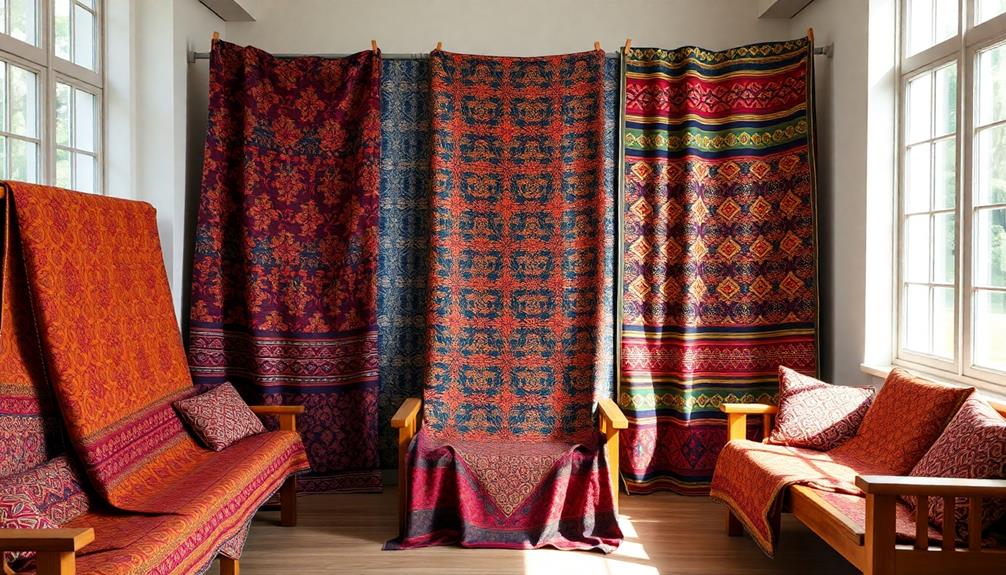
When exploring Indonesian textiles, you can't overlook batik's intricate patterns that tell stories through their designs.
The artistry of these textiles, much like the importance of Indonesian decor masks, highlights the rich cultural heritage and traditions of Indonesia.
Ikat offers a fascinating glimpse into cultural identity with its unique tie-dye techniques, while songket stands out for its luxurious appeal, often adorned with gold or silver threads.
Each of these textiles reflects the rich heritage and artistry of Indonesia, waiting for you to discover their significance.
Batik's Intricate Patterns
Batik's intricate patterns stand out as a vibrant expression of culture and artistry, enchanting anyone who encounters them. These textiles, recognized by UNESCO as a Masterpiece of Oral and Intangible Heritage, reveal the rich tapestry of Indonesian heritage through their detailed designs.
The use of natural materials and traditional techniques in crafting batik not only enhances its beauty but also aligns with the sustainable practices embraced in traditional Indonesian style home decor.
Here are a few intriguing aspects of batik's intricate patterns:
- Cultural Symbolism: Each motif tells a story, reflecting local narratives, social statuses, and family heritage.
- Artistic Techniques: The wax-resist dyeing method allows artisans to create complex patterns, showcasing their skill and creativity.
- Regional Diversity: Distinct styles emerge from regions like Solo and Yogyakarta, each reflecting unique cultural influences and artistic traditions.
Traditionally handcrafted by women, batik textiles embody both artistic talent and cultural significance, playing a crucial role in Indonesian society and rituals.
The intricate patterns not only beautify garments but also serve as a connection to the past, making them a perfect conversation starter for your guests.
When you showcase batik in your home, you're not just displaying art; you're sharing a piece of Indonesia's rich history and the stories woven into each thread.
Ikat's Cultural Identity
Ikat textiles embody the essence of Indonesian cultural identity, showcasing a unique tie-dye technique that transforms threads into vibrant patterns. This traditional method, especially warp ikat, involves dyeing the threads before weaving, resulting in intricate designs that tell stories of local beliefs and traditions.
These textiles are deeply connected to traditional Indonesian housing, as many homes feature ikat decor that reflects regional identities. You'll find that these textiles are mainly crafted by women in regions like Nusa Tenggara and Sumatra, highlighting their crucial role in preserving cultural heritage.
As you explore ikat, you'll notice its significance extends beyond aesthetics. Each piece often represents social status, with specific designs and motifs indicating tribe and district affiliations. When you wear a sarong or wrap yourself in a shawl made of ikat, you're not just embracing a beautiful textile; you're connecting with a rich cultural narrative.
The meticulous process of making ikat also reflects the skill and artistry of its weavers. They align and secure the threads with precision, resulting in blurred yet stunning patterns that resonate deeply within the community.
Songket's Luxurious Appeal
Celebrating the luxurious appeal of Songket textiles reveals a tapestry rich in history and artistry. Woven with exquisite gold or silver threads, Songket originates from Sumatra, particularly in Palembang. It's not just a fabric; it's a statement of culture and prestige, often reflecting the traditional craftsmanship that's a hallmark of Indonesian design.
Here are a few reasons why Songket stands out:
- Cultural Significance: Traditionally worn during ceremonial occasions, it symbolizes power and high status.
- Artistic Craftsmanship: Intricate motifs reflect local culture and nature, showcasing the weavers' exceptional artistry.
- Economic Importance: Often part of a woman's dowry or inheritance, it holds deep cultural and economic value in communities.
When you incorporate Songket into your decor or wardrobe, you instantly elevate your space or style. The shimmering gold and silver threads create a striking visual appeal that captivates onlookers.
Whether draped elegantly or displayed as art, Songket is more than just a textile; it's a conversation starter and a reflection of Indonesia's rich heritage. Embrace its luxurious allure, and watch your guests be wowed by its beauty and significance.
Contemporary Artistic Interpretations
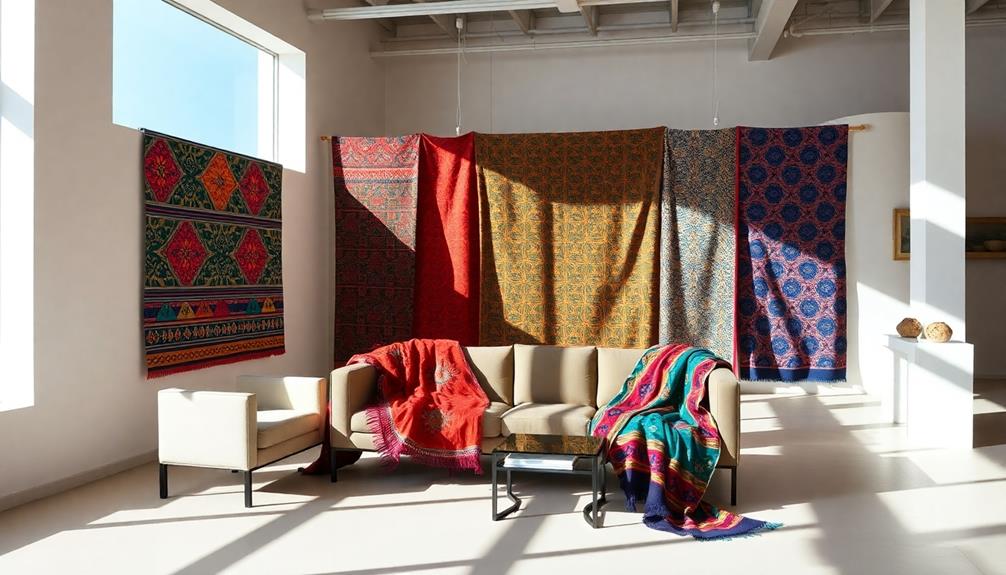
Contemporary artistic interpretations of Indonesian textiles are transforming the landscape of modern art, where traditional techniques meld seamlessly with innovative design.
Artists today are increasingly incorporating methods like batik and ikat, blending cultural heritage with a modern aesthetic that captivates global audiences. You'll find vibrant colors and intricate patterns reflecting the rich history and cultural significance of textiles of Indonesia, while also pushing the boundaries of design. This is particularly evident in Indonesian wedding decor ideas, where traditional patterns become stunning elements of celebration.
Collaborations between traditional artisans and contemporary designers are giving rise to new interpretations that cater to both local and international markets.
Exhibitions such as "Contemporary Worlds: Indonesia" highlight how these modern interpretations can tell fresh stories, engaging viewers with the cultural narratives rooted in time-honored practices.
Moreover, the growing trend of sustainable fashion has sparked renewed interest in artisanal Indonesian textiles.
Designers prioritize ethical craftsmanship and cultural storytelling, utilizing these beautiful fabrics in contemporary collections.
This fusion of old and new not only preserves traditional techniques but also showcases their relevance in today's world, making Indonesian textiles a powerful element in contemporary art and design.
Integrating Textiles Into Decor
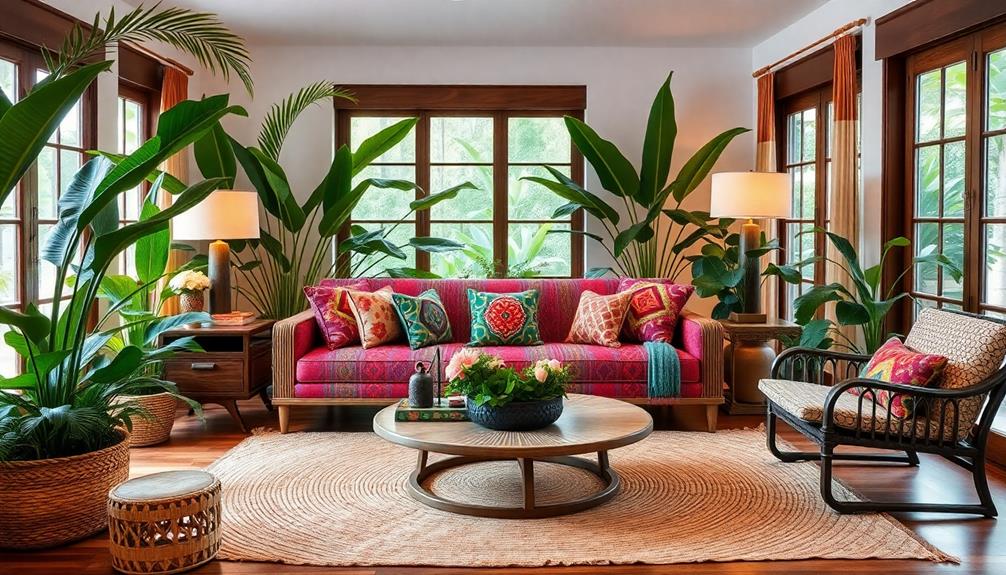
When you integrate Indonesian textiles into your decor, think about layering different fabrics to create depth and visual interest. For example, consider using a batik table runner over a solid tablecloth, or draping a traditional ikat cloth over a chair or sofa. You can also incorporate Indonesian textiles into throw pillows or wall hangings to add pops of color and pattern throughout your space. When it comes to Indonesian fabric mixing ideas, don’t be afraid to experiment with combining different textures and colors to create a unique and dynamic look.
Incorporating pieces that reflect the rich diversity of traditional Indonesian houses can enhance the cultural narrative of your space.
Statement pieces like a vibrant batik wall hanging can transform a space, making it feel more inviting and culturally rich.
Textile Layering Techniques
Incorporating textile layering techniques into your decor can transform a space, infusing it with the rich cultural heritage of Indonesia. By combining various Indonesian fabrics like batik, ikat, and songket, you can create a visually stunning arrangement that celebrates artisan skills and regional diversity.
For a truly luxurious touch, consider integrating elements from Mahallati Interiors to enhance the overall aesthetic appeal. Here's how you can elevate your interior design:
- Use contrasting textures: Mix heavy songket with lightweight batik for visual interest.
- Play with colors: Layer vibrant ikat cushions against neutral backgrounds for a pop.
- Tell a story: Each piece, from Ulos to Tenun, has a history that enriches your decor.
Consider how warp threads in these textiles contribute to their unique patterns and meanings.
By layering textiles of different weights and materials, you not only enhance the aesthetic appeal of your space but also create a dynamic visual impact.
Decorative applications like batik table runners and ikat cushions serve functional purposes while acting as conversation starters. This approach allows for seasonal adjustments in decor and honors the traditional techniques behind each piece.
Let your home reflect the beauty and depth of Indonesian textiles through thoughtful layering.
Statement Pieces in Spaces
Transform your space with statement pieces that showcase the beauty of Indonesian textiles. Using vibrant batik or luxurious songket as focal points can elevate your room's aesthetic, bringing rich narratives from the Indonesian archipelago right into your home. Consider incorporating these textiles in various forms:
| Type of Textile | Usage | Impact |
|---|---|---|
| Batik | Wall hangings | Adds color and history |
| Ikat | Cushions | Provides texture and warmth |
| Songket | Table runners | Highlights craftsmanship |
| Tenun | Throws or blankets | Creates comfort and style |
These unique decorative elements not only reflect regional identities but also serve as conversation starters. The bold patterns and colors of traditional textiles can seamlessly fit into design themes ranging from bohemian to contemporary. By choosing statement textiles that resonate with your personal or cultural significance, you'll create an atmosphere that truly represents your style and appreciation for global craftsmanship. So, embrace the artistry of Indonesian artisans and let your decor tell an enchanting story.
Care and Preservation Tips
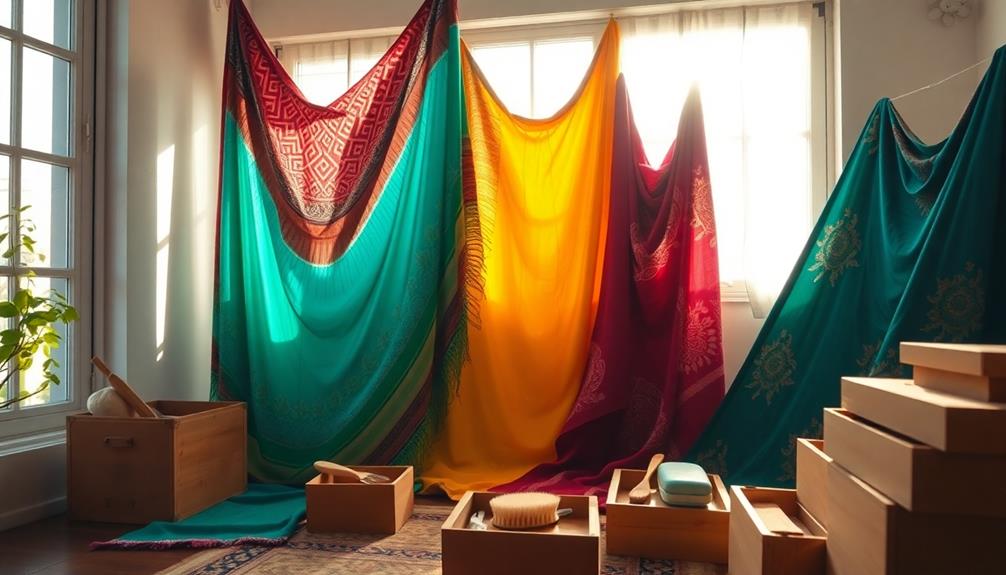
Indonesian textiles are beautiful treasures that require careful handling to maintain their vibrant colors and intricate designs. To guarantee their long-lasting beauty, follow these essential care and preservation tips:
- Wash gently in cold water with a mild detergent
- Store in a cool, dry place, away from direct sunlight
- Inspect regularly for signs of wear or pest damage
When washing, avoid harsh chemicals that can damage the fabric. Instead, opt for cold water and a mild detergent to preserve their rich hues.
For storage, keep your textiles in a cool, dry environment to prevent fading and deterioration. Utilize acid-free tissue paper to maintain their shape and avoid creasing.
It's best not to hang textiles for extended periods; fold them loosely and store them flat or rolled to prevent stress on the fibers that could distort the patterns.
When displaying, consider using UV-filtering glass in frames or display cases. This protects your textiles from harmful light exposure, guaranteeing they remain stunning focal points in your decor.
Resources for Further Exploration
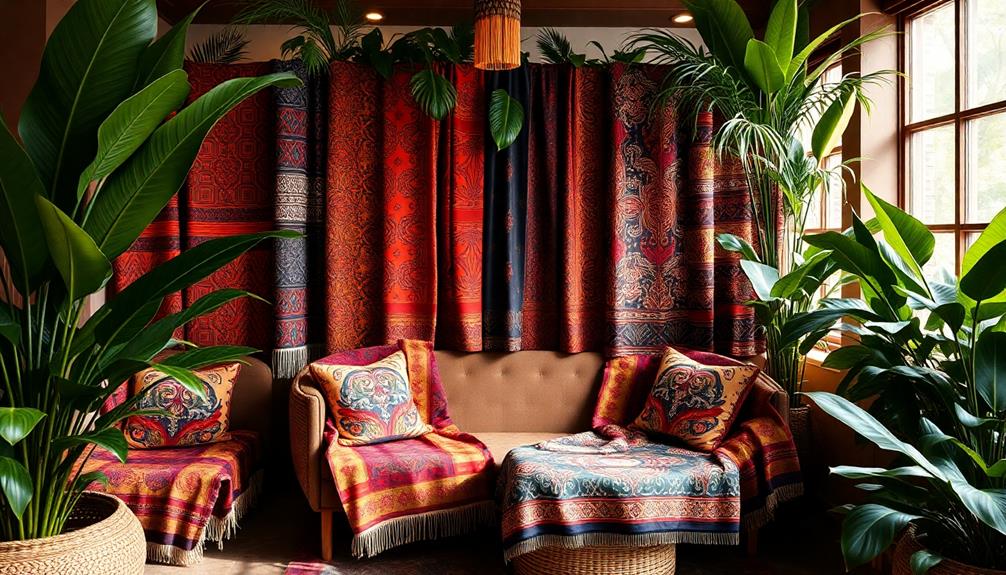
While exploring the world of Indonesian textiles, you'll find a wealth of resources that deepen your understanding and appreciation of this vibrant art form. The National Gallery of Australia is a fantastic starting point, housing over 1,200 Indonesian textiles with extensive online access. Here, you can study the intricate threads and patterns that define this unique craft.
You might also want to check out the Australia-Indonesia Institute, which actively supports the documentation and public access of these textiles. Their virtual resources promote further scholarship and interest, making it easier for you to dive deeper into this topic.
Consider participating in educational workshops, like "Activating the Peter Townsend Collection," to enhance your appreciation of the cultural significance behind each textile.
Additionally, the Asian Art Provenance Project focuses on the repatriation of artworks, including textiles, enriching cultural narratives that connect you to their origins.
Lastly, online platforms and exhibitions showcase contemporary uses of traditional Indonesian textiles, illustrating their relevance in modern design and fashion.
Frequently Asked Questions
What Is the Famous Fabric Design of Indonesia?
The famous fabric design of Indonesia is batik. You'll love its intricate patterns that tell stories through natural and mythological themes. This unique art form showcases a rich cultural heritage that captivates anyone who sees it.
What Is a Form of Textile Design From Indonesia?
In Indonesia, textiles like Batik symbolize life's intricate patterns. When you explore this art, you'll discover stories woven in every thread, connecting you to nature and culture, enriching your appreciation for craftsmanship and heritage.
What Was the Name of One of the People Groups Who Created Textiles?
One of the people groups that creates textiles is the Batak people from North Sumatra. Their traditional fabric, Ulos, is rich in cultural significance and often used in important ceremonies and celebrations throughout their communities.
What Are the Traditional Uses of Textiles of Bali?
In Bali, you'll find traditional textiles used for weddings, religious festivals, and rituals. They symbolize wealth and community, embodying love and friendship while honoring deities with intricate designs and vibrant colors that reflect local beliefs.
Conclusion
As you embrace the beauty of Indonesian textiles, you'll find they're more than just decor; they're a bridge to rich traditions and stories. Picture your guests' faces lighting up as they admire the intricate patterns and vibrant colors, each piece sparking a conversation about culture and artistry. Coincidentally, these textiles might just remind you of cherished memories with loved ones, making your space not only stunning but deeply meaningful. Let these textiles weave their magic into your home.
